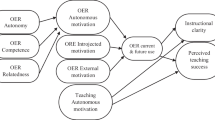Abstract
Textbooks have played an important role in education for decades. Given the significant number of technology applications in education, it is not surprising that at least one such application is the electronic textbook (e-textbook). There are a variety of motivations to adopt an e-textbook, including frequent content updates and low costs. The research presented here examines students’ behavioral intentions to purchase an e-textbook when given the choice. The theoretical foundation of the research is provided by social cognitive theory. The data used in the empirical study were collected by distributing a questionnaire to students at a medium-sized university in the western United States. Student responses used in the analysis all reported prior use of an e-textbook. The model was estimated using a structural equations approach. The results showed that both ease of e-textbook use and verbal persuasion/social norm positively influence behavioral intentions to purchase an e-textbook through both self-efficacy and outcome expectancy/usefulness. Previous computer experience positively influences behavioral intentions to purchase an e-textbook only through self-efficacy. Based on these results, conclusions are provided.



Similar content being viewed by others
References
Allen, N. (2009). Course correction: How digital textbooks are off track, and how to set them straight? (pp. 1–21). Chicago: The Student Public Interest Research Group.
Anderson, J. C., & Gerbing, D. W. (1988). Structural equations modeling in practice: A review and recommended two-step approach. Psychological Bulletin, 103(3), 411–423.
Ballhaus, W., van der Donk, M., & Stokes, P. (2010). Turning the page: The future of ebooks (Vol. Technology, Media and Telecommunications): Price Waterhouse Coopers.
Bandura, A. (1977). Self-efficacy: Toward a unifying theory of behavioral change. Psychological Review, 84(2), 191–215.
Bandura, A. (1982). Self-Efficacy mechanism in human agency. American Psychologist, 37, 122–147.
Bandura, A. (1986). Social foundation of thought and action: A social cognitive theory. NJ: Prentice-Hall.
Barbeite, F. G., & Weiss, E. M. (2004). Computer self-efficacy and anxiety scales for an Internet sample: Testing measurement equivalence of existing measures and development of new scales. Computers in Human Behavior, 20, 1–15.
Baronas, A. K., & Louis, M. R. (1988). Restoring a sense of control during implementation: How user involvement leads to system acceptance? MIS Quarterly, 12(1), 111–123.
Bates, R., & Khasawneh, S. (2007). Self-efficacy and college students’ perceptions and use of online learning systems. Computers in Human Behavior, 23, 175–191.
Beezer, R. (2009). The truly free textbook. EduCause Review, 44(1), 23–24.
Birch, A., & Irvine, V. (2009). Preservice teachers’ acceptance of ICT integration in the classroom: Applying the UTAUT model. Educational Media International, 46(4), 295–315. doi:10.1080/09523980903387506.
Brown, M. (2009). The NetGens 2.0: Clouds on the horizon. EduCause Review, 44(1), 66–67.
Busch, T. (1995). Gender differences in self-efficacy and attitudes toward computers. Journal of Educational Computing Research, 12, 147–158.
Compeau, D. R., & Higgins, C. A. (1995). Computer self-efficacy: Development of a measure and initial test. MIS Quarterly, 19(2), 189–211.
Davis, F. D. (1989). Perceived usefulness, perceived ease of use, and user acceptance of information technology. MIS Quarterly, 13(3), 319–339.
Dillon, N. (2008). The evolving textbook. American School Board Journal, 195(7), 20–23.
Ellison, N. B., Steinfield, C., & Lampe, C. (2007). The benefits of Facebook ‘‘friends:’’ Social capital and college students’ use of online social network sites. Journal of Computer-Mediated Communication, 12(4), 1143–1168.
Fornell, C., & Larcker, D. F. (1981). Evaluating structural equation models with unobservable variables and measurement error. Journal of Marketing Research, XVIII, 39–50.
Hair, J., Jr., Anderson, R. E., Tatham, R. L., & Black, W. C. (1992). Multivariate data analysis: With readings. New York: MacMillan.
Hasan, B. (2003). The influence of specific computer experiences on computer self-efficacy beliefs. Computers in Human Behavior, 19(4), 443–450.
Havelka, D. (2003). Predicting software self-efficacy among business students: A preliminary assessment. Journal of Information Systems Education, 14(2), 145.
Henry, J. W., & Stone, R. W. (1995a). Computer self-efficacy and outcome expectancy: The effects on the end-user’s job satisfaction. Computer Personnel, 16(4), 15–34.
Henry, J. W., & Stone, R. W. (1995b). End-user perceptions of a computer-based medical information system’s impact on patient care. Journal of Health Information Management Research, 3(2), 1–16.
Henry, J. W., & Stone, R. W. (1999). End-user perceptions of the impacts of computer self-efficacy and outcome expectancy on job performance and patient care when using a medical information system. International Journal of Healthcare Technology and Management, 1(1, 2), 103–112.
Henry, J. W., & Stone, R. W. (2001). The role of computer self-efficacy, outcome expectancy, and attribution theory in impacting computer system use. Journal of International Information Management, 10(1), 1–16.
Hill, R. (2010). Turning the page: Forget about those bulky backbreakers, digital textbooks are the future. School Library Journal, 24–27. Retrieved from website: http://www.schoollibraryjournal.com/slj/home/886880-312/turning_the_page_forget_about.html.csp.
Hooper, D., Caughlan, J., & Mullen, M.R. (2008). Structural equation modelling: Guidelines for determining model fit. Electronic Journal of Business Research Methods, 6(1), 53–60. Retrieved from website: http://www.ejbrm.com/front/search/index.html.
Hughes, A. D., Price, R. L., & Marrs, D. W. (1986). Linking theory construction and theory testing: Models with multiple indicators of latent variables. Academy of Management Review, 11(1), 128–144.
Igbaria, M., & Greenhaus, J. H. (1992). Determinants of MIS employee’s turnover intentions: A structural equation model. Communications of the ACM, 35, 35–49.
Iivari, J. (2005). An empirical test of the DeLone–McLean model of information system success. The Data Base for Advances in Information Systems, 36(2), 8–27.
Luszczynska, A., Scholz, U., & Schwarzer, R. (2005). The general self-efficacy scale: Multicultural validation studies. Journal of Psychology, 139(5), 439.
Martinko, M. J., Henry, J. W., & Zmud, R. W. (1996). An attributional explanation of individual resistance to the introduction of information technologies in the workplace. Behaviour & Information Technology, 15(5), 313–330.
McQuiggan, S. W., Mott, B. W., & Lester, J. C. (2008). Modeling self-efficacy in intelligent tutoring systems: An inductive approach. User Modeling and User Adapted Interaction, 18(1–2), 81–123. doi:10.1007/s11257-007-9040-y.
Meier, S. T. (1985). Computer aversion. Computers in Human Behavior, 1(2), 171–179.
Nelson, M. R., & Hains, E. (2010). E-books in higher education: Are we there yet? EDUCAUSE Center for Applied Research, Research Bulletin, 2. Retrieved from website: http://www.educase.edu/ecar.
Niemuth, T. (2010). New tools for student engagement. Leadership, 39(3), 24–27.
Nunnally, J. (1978). Psychometric methods (2nd ed.). New York: McGraw-Hill.
Pendegraft, N., Rounds, M., & Stone, R. W. (2010). Factors influencing college students’ use of computer security. International Journal of Information Security and Privacy, 4(3), 51–60.
Potosky, D. (2002). A field study of computer efficacy beliefs as an outcome of training: The role of computer playfulness, computer knowledge, and performance during training. Computers in Human Behavior, 18(3), 241–255.
Potosky, D., & Bobko, P. (1998). The computer understanding and experience scale: A self-report measure of computer experiences. Computers in Human Behavior, 14(2), 337–348.
Rachlin, N. (2011). Digital textbooks slow to catch on: Lower prices fail to spur sales, but study hints at boost with rise of tablets. The International Herald Tribune, p. 18.
Rai, A., Lang, S. S., & Welker, R. B. (2002). Assessing the validity of IS success models: An empirical test and theoretical analysis. Information Systems Research, 13(1), 50–69.
Rainer, R. K., Jr, & Harrison, A. W. (1993). Toward development of the end user computing construct in a university setting. Decision Sciences Journal, 24(6), 1187–1202.
Rampell, C. (2008). Free textbooks: An online company tries a controversial publishing model. Chronicle of Higher Education, 14–15. Retrieved from website: http://chronicle.com.
Reynolds, R. (2011). Trends influencing the growth of digital textbooks in US higher education. Publishing Research Quarterly, 27(2), 178–187.
Sang-ho, S. (2011). All textbooks to go digital by 2012. Seoul: The Korea Herald.
Seidel, K. (2009). Online textbooks: Deliver timely, real-world content. EduCause Review, 44(1), 28–30.
Shiratuddin, N., Landoni, M., Gibb, F., & Hassan, S. (2003). E-book technology and its potential applications in distance education. Journal of Digital Information, 3(4). Retrieved from website: http://journals.tdl.org/index.php/jodi/article/view/90/89.
Staples, D. S., Hulland, J. S., & Higgins, C. A. (1998). A self-efficacy theory explanation for the management of remote workers in virtual organizations. Journal of Computer-Mediated Communication, 3(4), 48–65.
Stewart, R. (2009). Some thought on free textbooks. EduCause Review, 44(1), 24–26.
Stone, R. W., & Henry, J. W. (2003). The roles of computer self-efficacy and outcome expectancy in influencing the computer end-user’s organizational commitment. Journal of End User Computing, 15(1), 38–53.
Sweeney, M. J., Siegfried, J. J., Raymond, J. E., & Wilkinson, J. T. (1983). The structure of the introductory economics course in United States colleges. The Journal of Economic Education, 14(4), 68–75.
Thompson, B. (1997). The importance of structure coefficients in structural equation modeling confirmatory factor analysis. Educational and Psychological Measurement, 57(1), 5–19.
Tsai, M.-T., & Cheng, N. C. (2010). Programmer perceptions of knowledge-sharing behavior under social cognitive theory. Expert Systems with Applications, 37(12), 8479–8485.
Venkatesh, V., & Davis, F. D. (2000). A theoretical extension of the technology acceptance model: Four longitudinal field studies. Management Science, 46(2), 186–204.
Venkatesh, V., Morris, M., Davis, G. B., & Davis, F. D. (2003). User acceptance of information technology: Towards a unified view. MIS Quarterly, 27(3), 425–478.
Weisberg, M. (2011). Student attitudes and behaviors towards digital textbooks. Publishing Research Quarterly, 27(2), 188–196.
Wilson, B. C., & Shrock, S. (2001). Contributing to success in an introductory computer science course: A study of twelve factors. ACM SIGCSE Bulletin, 33(1), 184–188.
Woody, W. D., Daniel, D. B., & Baker, C. A. (2010). E-books or textbooks: Students prefer textbooks. Computers & Education, 55(3), 945–948.
Yi, M. Y., & Hwang, Y. (2003). Predicting the use of web-based information systems: Self-efficacy, enjoyment, learning goal orientation, and the technology acceptance model. International Journal of Human-Computer Studies, 59, 431–449.
Author information
Authors and Affiliations
Corresponding author
Rights and permissions
About this article
Cite this article
Stone, R.W., Baker-Eveleth, L.J. Students’ intentions to purchase electronic textbooks. J Comput High Educ 25, 27–47 (2013). https://doi.org/10.1007/s12528-013-9065-7
Published:
Issue Date:
DOI: https://doi.org/10.1007/s12528-013-9065-7




